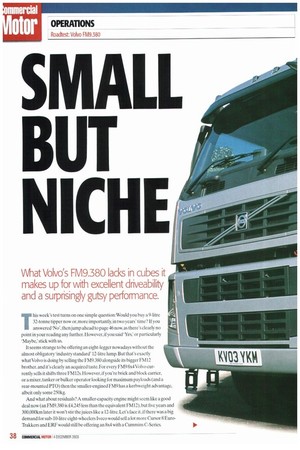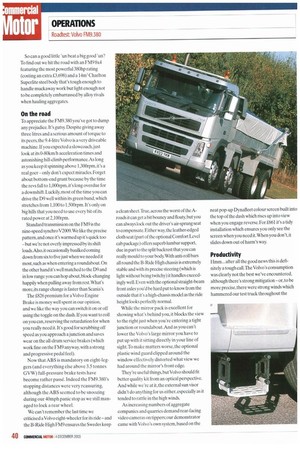S M A L L B UT _ _
Page 38

Page 40

Page 41

If you've noticed an error in this article please click here to report it so we can fix it.
Wnat Volvo's FM9.380 lacks in cubes it makes up for with excellent driveability and a surprisingly gutsy performance.
This week's test turns on one simple question: Would you buy a 9-litre 32-tonne tipper now or, more importantly, in two years' time? If you answered 'No', then jump ahead to page 46 now, as there's clearly no point in your reading any further. However, if you said 'Yes,' or particularly 'Maybe,' stick with us.
It seems strange to be offering an eight-legger nowadays without the almost obligatory 'industry standard' 12-litre lump. But that's exactly what Volvo is doing by selling the FM9.380 alongside its bigger FM12 brother, and it's clearly an acquired taste. For every FM9 8x4 Volvo currently sells it shifts three FM12s. However, if you're brick and block carrier, or a mixer, tanker or bulker operator looking for maximum payloads (and a rear-mounted PTO) then the smaller-engined FM9 has a kerbweight advantage, albeit only some 250kg.
And what about residuals? A smaller-capacity engine might seem like a good deal now (an FM9.380 is £4,245 less than the equivalent FM12). but five years and 300.000km later it won't stir the juices like a 12-litre. Let's face it, if there was a big demand for sub-10-litre eight-wheelers Iveco would sell a lot more Cursor 8 EuroTrakkers and ERF would still be offering an 8x4 with a Cummins C-Series. So can a good little 'tin beat a big good 'un? To find out we hit the road with an FM9 8x4 featuring the most powerful 380hp rating (costing an extra £3,698) and a 14mR Charlton Superlite steel body that's tough enough to handle muck away work but light enough not to be completely embarrassed by alloy rivals when hauling aggregates.
On the road
To appreciate the FM9.380 you've got to dump any prejudice. It's gutsy. Despite giving away three litres and a serious amount of torque to its peers, the 9.4-litre Volvo is a very driveable machine. If you expected a slowcoach.just look at its 0-80km/h acceleration times and astonishing hill-climb performance.As long as you keep it spinning above.' ,300rpm, it's a real goer only don't expect miracles. Forget about bottom-end grunt because by the time the revs fall to 1,000rpm, it's long overdue for a downshift.Luckily,most of the time you can drive the D9 well within its green band, which stretches from 1,100 to 1,500rpm. It's only on big hills that you need to use every bit of its rated power at 2,100rpm.
Standard transmission on the FM9 is the nine-speed synchroV2009.We like the precise pattern, and once it's warmed up it's quick too but we're not overly impressed by its shift loads.Also.it occasionally baulked coming down from six to five just when we needed it most,such as when entering a roundabout. On the other hand it's well matched to the D9 and in low range you can hop about, block-changing happily when pulling away from rest. What's more, its range change is faster than Scania's.
The £826 premium for a Volvo Engine Brake is money well spent in our opinion, and we like the way you can switch it on or off using the toggle on the dash. If you want to roll on you can, reserving the retardation for when you really need it. It's good for scrubbing off speed as you approach a junction and saves wear on the all-drum service brakes (which work fine on the FM9 anyway,with a strong and progressive pedal feel).
Now that ABS is mandatory on eight-leggers (and everything else above 3.5 tonnes GVW) full-pressure brake tests have become rather passé. Indeed the FM9.380's stopping distances were very reassuring, although the ABS seemed to be snoozing during our 40mph panic stop as we still managed to lock a rear wheel.
We can't remember the last time we criticised a Volvo eight-wheeler for its ride and the B-Ride High FM9 ensures the Swedes keep a clean sheet.True, across the worst of the Aroads it can get a bit bouncy and floaty, but you can always lock out the driver's air-sprung seat to compensate. Either way, the leather-edged cloth seat (part of the optional Comfort Level cab package) offers superb lumbar support, due in part to the split backrest that you can really mould to your body. With anti-roll bars all round the B-Ride High chassis is extremely stable and with its precise steering (which is light without being twitchy) it handles exceedingly well. Even with the optional straight-beam front axles you'd be hard put to know from the outside that it's a high-chassis model as the ride height looks perfectly normal.
While the mirror pack is excellent for showing what's behind you, it blocks the view to the right just when you're entering a tight junction or roundabout. And as you can't lower the Volvo's large mirror you have to put up with it sitting directly in your line of sight.To make matters worse, the optional plastic wind guard clipped around the window effectively distorted what view we had around the mirror's front edge.
They're useful things, but Volvo should fit better quality kit from an optical perspective. And while we're at it, the external sun visor didn't do anything for us either, especially as it tended to rattle in the high winds.
As increasing numbers of aggregate companies and quarries demand rear-facing video cameras on tippers; our demonstrator came with Volvo's own system, based on the neat pop-up Dynafleet colour screen built into the top of the dash which rises up into view when you engage reverse. For £661 it's a tidy installation which ensures you only see the screen when you need it. When you don't, it slides down out of harm's way.
Productivity
1 IMM... a icr all the good news this is definitely a tough call. The Volvo's consumption was clearly not the best we've encountered, although there's strong mitigationor, to be more precise, there were strong winds which hammered our test truck throughout the two-day test. Getting held up on more than our fair share of roundabouts on the A-road section. and by slow-moving fuel tankers and roadworks. didn't help either. Faster diffs might have come in handy on the motorway, but you can only get them in the CTEV87 bogie with a welded casing. and they probably wouldn't have helped gradeability.
So we must assume the FM9.380's overall 7.01mpg is a one-off result. On the motorway, at least, it isn't that far adrift from the pack. However,we've no complaints about the FM9's running times, especially on A-roads, which proves how well it goes with the flow. Finally, if you're buying an FM9 for maximum payloads, you're not going to spec a steel body, as on OUT demo, which explains its rather hefty tare of 12.160kg fully fuelled and with a driver on board.
Cab comfort First,a word on access.The FM's sharply raked screen and not-quite-90°opening door tends to push you over to the left as you climb up, but at least the steps stand out well. However, we can't see many drivers bothering with the bottom one; we instinctively used the second step when getting in and out.
Once inside you're confronted by the typically Swedish curving dash and a high engine hump that seriously restricts movement. The dash layout and interior colour scheme are practical. while the finish is solid, particularly the ultra-thick rubber covering over the dash (another item in the Comfort Cab pack).
Ignoring all those extra blanked-off switches which will just collect cement dust. instrumentation is good.The dials and gauges are clearly visible,which is more that can be said for the control stalks under the steering wheel.Fortunately.you can adjust the wheel easily for height and rake. and the driver's seat is very comfortable.
Storage space is restricted to a couple of cubby boxes in the headlining. a small tray on the rear wall and a central box on the engine hump. but you'll find plenty of drinks holders. including in the door pockets. If you need to hang up a coat there's a rail on the back wall, or you can sling your kit behind the seats.
The switch cluster on the top of the driver's door panel controlling the mirrors and windows is a nice touch,as is the foot-operated red light that illuminates the footwell at night. There's plenty of power in the heating and ventilating system too. While some potential buyers might be deterred by the extra £1.642 for the Comfort pack. it includes climate controLextra mats, a roof hatch and tinted windows among other goodies. •
































































































































































































